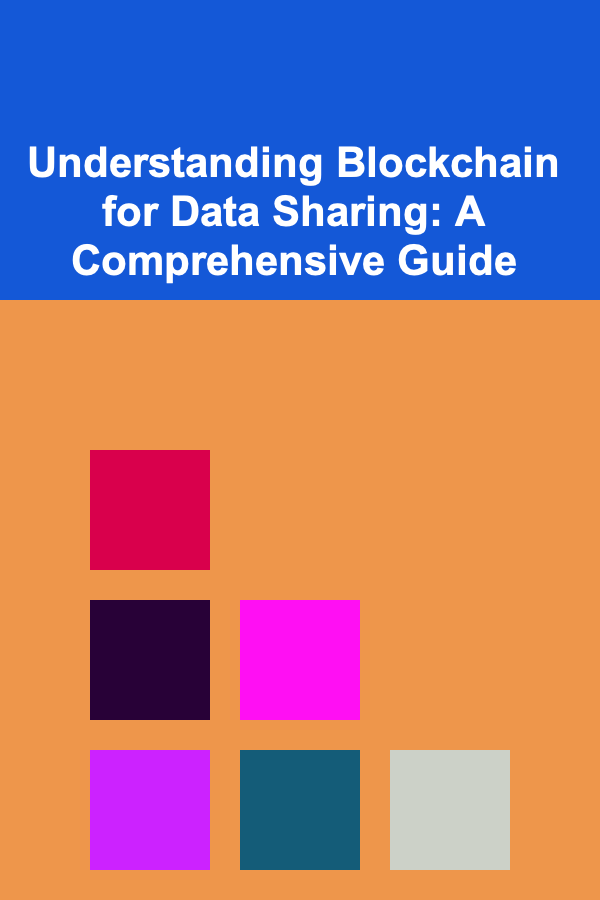
Understanding Blockchain for Data Sharing: A Comprehensive Guide
ebook include PDF & Audio bundle (Micro Guide)
$12.99$6.99
Limited Time Offer! Order within the next:

Data sharing is the cornerstone of modern innovation, collaboration, and efficiency across various industries. From healthcare and finance to supply chain management and research, the ability to securely and efficiently share data is paramount. However, traditional data sharing methods often suffer from issues related to security, transparency, trust, and control. This is where blockchain technology emerges as a potential game-changer, offering a decentralized, secure, and transparent infrastructure for data sharing.
What is Blockchain Technology?
At its core, a blockchain is a distributed, immutable ledger that records transactions in a sequential, verifiable manner. Think of it as a shared, digital record book that is replicated across multiple computers (nodes) in a network. Each transaction is grouped into a "block," and these blocks are chained together chronologically using cryptographic techniques. This "chain" structure, combined with cryptographic hashing, ensures the integrity and security of the data stored within the blockchain.
Key characteristics of blockchain technology include:
- Decentralization: No single entity controls the blockchain. Instead, control is distributed across the network of nodes.
- Immutability: Once a block is added to the chain, it cannot be altered or deleted. Any changes require creating a new block, leaving the original block intact and auditable.
- Transparency: All transactions recorded on the blockchain are typically publicly visible (depending on the blockchain's permissioning model). This transparency enhances trust and accountability.
- Security: Cryptographic techniques, such as hashing and digital signatures, are used to secure the blockchain and protect data from tampering.
- Consensus Mechanism: A consensus mechanism, such as Proof-of-Work (PoW) or Proof-of-Stake (PoS), ensures that all nodes in the network agree on the validity of new blocks before they are added to the chain.
How Blockchain Enables Secure Data Sharing
Blockchain offers several advantages over traditional data sharing methods, particularly in terms of security and trust:
- Enhanced Security: The cryptographic techniques used in blockchain make it highly resistant to hacking and data breaches. Each block is cryptographically linked to the previous block, making it extremely difficult to alter or delete data without detection. The use of private and public key cryptography allows for secure authentication and authorization, ensuring that only authorized parties can access and modify data.
- Improved Data Integrity: The immutability of the blockchain ensures that data remains tamper-proof. Any attempt to modify a block would require altering all subsequent blocks in the chain, which is computationally infeasible. This guarantees the integrity and reliability of the shared data.
- Increased Transparency: The transparent nature of blockchain allows all participants to view the history of data transactions. This transparency fosters trust and accountability among stakeholders, as all actions are recorded and auditable.
- Decentralized Control: Blockchain eliminates the need for a central authority to manage and control data. Data is distributed across the network, reducing the risk of a single point of failure and enhancing resilience.
- Smart Contracts: Smart contracts are self-executing contracts written in code and stored on the blockchain. They can automate data sharing processes and enforce pre-defined rules and agreements, ensuring that data is shared according to specific conditions.
- Data Provenance and Auditability: Blockchain provides a complete and verifiable audit trail of all data transactions. This allows for easy tracking of data provenance, ensuring that the origin and history of data are known and trusted.
Different Types of Blockchains for Data Sharing
Not all blockchains are created equal. Different types of blockchains offer varying levels of access, control, and privacy. Understanding these differences is crucial for selecting the right blockchain for a specific data sharing application.
- Public Blockchains: Public blockchains, such as Bitcoin and Ethereum, are permissionless and open to anyone. Anyone can participate in the network, view transactions, and contribute to the consensus process. While highly transparent and secure, public blockchains may not be suitable for sensitive data sharing due to the lack of privacy controls.
- Private Blockchains: Private blockchains are permissioned and controlled by a single organization or entity. Only authorized participants can access and modify data on the blockchain. Private blockchains offer greater control over data privacy and security but sacrifice some of the transparency and decentralization benefits of public blockchains. They are useful for internal data sharing within an organization or among a closed group of partners.
- Consortium Blockchains: Consortium blockchains are permissioned blockchains governed by a group of organizations or entities. They offer a balance between the transparency of public blockchains and the control of private blockchains. Consortium blockchains are suitable for data sharing among a group of collaborating organizations, such as a supply chain consortium or a research network.
- Hybrid Blockchains: Hybrid blockchains combine elements of both public and private blockchains. They may use a public blockchain for certain aspects of data sharing, such as data verification, while using a private blockchain for sensitive data storage and access control.
Use Cases of Blockchain for Data Sharing
Blockchain technology has the potential to revolutionize data sharing across a wide range of industries. Here are some notable use cases:
- Healthcare: Blockchain can enable secure and interoperable sharing of patient medical records among healthcare providers. This can improve patient care, reduce medical errors, and streamline administrative processes. Patients can also have greater control over their own medical data and grant access to specific providers as needed.
- Supply Chain Management: Blockchain can provide a transparent and immutable record of product provenance, from origin to delivery. This can help combat counterfeiting, improve supply chain efficiency, and enhance consumer trust. Participants can track the movement of goods, verify authenticity, and ensure compliance with regulations.
- Financial Services: Blockchain can streamline cross-border payments, reduce fraud, and improve transparency in financial transactions. It can also enable secure and efficient sharing of customer data among financial institutions for KYC (Know Your Customer) and AML (Anti-Money Laundering) compliance.
- Intellectual Property (IP) Management: Blockchain can provide a secure and tamper-proof platform for registering and managing intellectual property rights. Creators can register their works on the blockchain, establishing proof of ownership and creating a transparent record of licensing and transfers.
- Research and Development: Blockchain can facilitate secure and collaborative data sharing among researchers, accelerating scientific discoveries and promoting innovation. Researchers can share data and findings in a secure and transparent environment, ensuring data integrity and attribution.
- Government and Public Sector: Blockchain can improve transparency and accountability in government operations, such as land registry, voting systems, and identity management. It can also facilitate secure and efficient data sharing among government agencies.
- Personal Data Management: Blockchain-based platforms allow individuals to take control of their personal data and decide who has access to it. Users can grant permission to specific organizations or services to access their data, and revoke access at any time. This empowers individuals to manage their digital identity and protect their privacy.
Challenges and Considerations
While blockchain offers significant potential for data sharing, there are also challenges and considerations that need to be addressed:
- Scalability: Some blockchain networks have limitations in terms of transaction throughput, which can hinder their ability to handle large volumes of data sharing.
- Interoperability: Different blockchain platforms may not be compatible with each other, making it difficult to share data across different blockchain networks. Standardization efforts are needed to improve interoperability.
- Data Privacy: While blockchain offers enhanced security, it's important to carefully consider data privacy regulations, such as GDPR, when using blockchain for data sharing. Techniques like zero-knowledge proofs and homomorphic encryption can be used to protect data privacy while still enabling data sharing.
- Regulatory Uncertainty: The regulatory landscape surrounding blockchain technology is still evolving, which can create uncertainty for organizations considering adopting blockchain for data sharing.
- Complexity: Implementing and managing blockchain solutions can be complex, requiring specialized skills and expertise. Organizations need to invest in training and education to ensure successful blockchain deployments.
- Governance: Establishing clear governance structures and protocols is crucial for ensuring the long-term sustainability and effectiveness of blockchain-based data sharing systems. This includes defining roles and responsibilities, setting rules for data access and modification, and establishing mechanisms for dispute resolution.
- Energy Consumption: Some blockchain consensus mechanisms, such as Proof-of-Work (PoW), can consume significant amounts of energy. More energy-efficient consensus mechanisms, such as Proof-of-Stake (PoS), are being developed to address this concern.
Implementing Blockchain for Data Sharing: A Step-by-Step Approach
Successfully implementing blockchain for data sharing requires careful planning and execution. Here's a step-by-step approach:
- Define the Problem and Objectives: Clearly define the specific data sharing problem you are trying to solve and the objectives you want to achieve. Identify the stakeholders involved and their requirements.
- Assess Data Sharing Requirements: Analyze the types of data to be shared, the sensitivity of the data, the frequency of data sharing, and the required level of security and privacy.
- Choose the Right Blockchain Platform: Select the appropriate blockchain platform based on your specific requirements, considering factors such as permissioning model, scalability, interoperability, and cost. Evaluate public, private, consortium, and hybrid blockchain options.
- Design the Data Sharing Architecture: Design the architecture of your blockchain-based data sharing system, including the data model, smart contract logic, and access control mechanisms.
- Develop and Test the Solution: Develop the blockchain application and smart contracts, and thoroughly test the solution to ensure it meets your requirements and is secure.
- Deploy and Integrate the Solution: Deploy the blockchain solution and integrate it with existing systems and data sources.
- Monitor and Maintain the Solution: Continuously monitor the performance and security of the blockchain solution and make necessary updates and improvements.
- Address Governance and Compliance: Establish clear governance structures and protocols for data sharing, and ensure compliance with relevant regulations.
- Train Users and Stakeholders: Provide training to users and stakeholders on how to use the blockchain-based data sharing system and understand its benefits.
Examples of Blockchain-Based Data Sharing Platforms and Projects
The following are some examples of platforms and projects that leverage blockchain for data sharing:
- MediBloc: A blockchain-based healthcare platform that allows patients to securely store and manage their medical records and share them with healthcare providers.
- OriginTrail: A blockchain-based supply chain management platform that provides end-to-end traceability of products.
- TradeLens: A blockchain-based platform developed by IBM and Maersk for digitizing and streamlining global trade.
- Ocean Protocol: A decentralized data exchange protocol that allows individuals and organizations to monetize their data while preserving privacy.
- Filecoin: A decentralized storage network that allows users to store and retrieve files using blockchain technology.
The Future of Blockchain in Data Sharing
Blockchain technology is rapidly evolving, and its potential for data sharing is only beginning to be realized. As the technology matures and adoption increases, we can expect to see:
- Increased Interoperability: Greater interoperability between different blockchain platforms, enabling seamless data sharing across different networks.
- Enhanced Privacy Solutions: More advanced privacy-enhancing technologies, such as zero-knowledge proofs and homomorphic encryption, enabling secure data sharing without revealing sensitive information.
- Standardization Efforts: Wider adoption of industry standards for blockchain-based data sharing, promoting interoperability and reducing complexity.
- Integration with Other Technologies: Integration of blockchain with other emerging technologies, such as artificial intelligence (AI) and the Internet of Things (IoT), to create even more powerful data sharing solutions.
- Wider Adoption Across Industries: Increased adoption of blockchain for data sharing across a wider range of industries, from healthcare and finance to supply chain management and government.
- Focus on Data Sovereignty and Control: A growing emphasis on data sovereignty and individual control over personal data, with blockchain playing a key role in empowering individuals to manage their own data and decide who has access to it.
Conclusion
Blockchain technology offers a compelling solution for addressing the challenges of traditional data sharing methods. Its decentralized, immutable, and transparent nature provides a secure and trustworthy infrastructure for sharing data across various industries. While there are challenges and considerations to be addressed, the potential benefits of blockchain for data sharing are significant. By carefully planning and executing blockchain implementations, organizations can unlock the power of secure and efficient data sharing, driving innovation, collaboration, and efficiency.
As blockchain technology continues to evolve, it is crucial to stay informed about the latest developments and explore the potential applications of blockchain for data sharing in your specific industry. By embracing blockchain technology, organizations can transform the way they share data, unlocking new opportunities and creating a more collaborative and innovative future.

How to Build a Tool Shed on a Budget
Read More
How to Choose the Right Printing Method for Your T-Shirt Designs
Read More
How to Establish Communication Channels with Parents During Camp
Read More
How to Use Seasonal Decor to Keep Your Home Fresh
Read More
How To Think Like a Programmer
Read More
How to Restore Antique Metal Tools
Read MoreOther Products

How to Build a Tool Shed on a Budget
Read More
How to Choose the Right Printing Method for Your T-Shirt Designs
Read More
How to Establish Communication Channels with Parents During Camp
Read More
How to Use Seasonal Decor to Keep Your Home Fresh
Read More
How To Think Like a Programmer
Read More